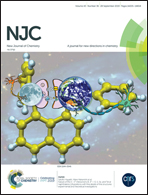Effect of new asymmetrical Zn(ii) phthalocyanines on the photovoltaic performance of a dye-sensitized solar cell†
Abstract
Asymmetric zinc phthalocyanine dyes bearing electron donating tert-butylsulfanyl or hexylsulfanyl groups and a carboxylic acid anchoring group that act as “push” and “pull”, respectively, have been designed, synthesized and used as sensitizers for dye-sensitized solar cells (DSSCs). Theoretical calculations of Gibbs free energy change performed with the B3LYP, HSE06 and M06 functionals show that there is not a unique trend but a preference by the 2-GT6-cs and 2-GT4-cs isomers as the most stable structures. Electronic absorption spectra calculated with time-dependent density functional theory (TD-DFT) (M06/6-311G(d,p)) in THF indicate that, taking as a reference GT6 isomers, a red-shift of the Q bands is produced for the GT4 isomers, with values up to 33 nm. Theoretical calculations show that the hexyl chains in GT4 are located along the molecular plane, but the tert-butyl moieties in GT6 are non-planar. Therefore, compared with the planar one, the non-planar compound shows both a slight blue shift in absorption and a lower tendency for dye aggregation. When the dyes were employed in DSSCs with chenodeoxycholic acid (CDCA) as a co-adsorbent, the power conversion efficiency (PCE) was obtained as 3.19% for GT4 and 3.08% for GT6 under full sunlight (AM 1.5, 100 mW cm−2) irradiation. This can be attributed to the higher dye loading of the DSSC sensitized with GT4. However, GT4 was considerably decomposed, while GT6 retained most of its initial optical properties after continuous sunlight exposure. This result demonstrates that the zinc phthalocyanine dye containing tert-butyl moieties shows excellent photostability.



 Please wait while we load your content...
Please wait while we load your content...